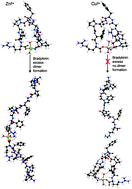Copper, differently from zinc, affects the conformation, oligomerization state and activity of bradykinin†
Abstract
The sole role of bradykinin (BK) as an inflammatory mediator is controversial, as recent data also support an anti-inflammatory role for BK in Alzheimer's disease (AD). The involvement of two different receptors (B1R and B2R) could be a key to understand this issue. However, although copper and zinc dyshomeostasis has been demonstrated to be largely involved in the development of AD, a detailed study of the interaction of BK with these two metal ions has never been addressed. In this work, we have applied mass spectrometry, circular dichroism as well as computational methods in order to assess if copper and zinc have the ability to modulate the conformation and oligomerization of BK. In addition, we have correlated the chemical data with the effect of metals on the activity of BK analyzed in cell cultures by biochemical procedures. The biochemical analyses on monocyte/macrophage cell culture (THP-1 Cell Line human) in line with the effect of metals on the conformation of BK showed that the presence of copper can affect the signaling cascade mediated by the BK receptors. The results obtained show a further role of metal ions, particularly copper, in the development and outcome of neuroinflammatory diseases. The possible implications in AD are discussed.

- This article is part of the themed collection: Zinc in the Biosciences

 Please wait while we load your content...
Please wait while we load your content...